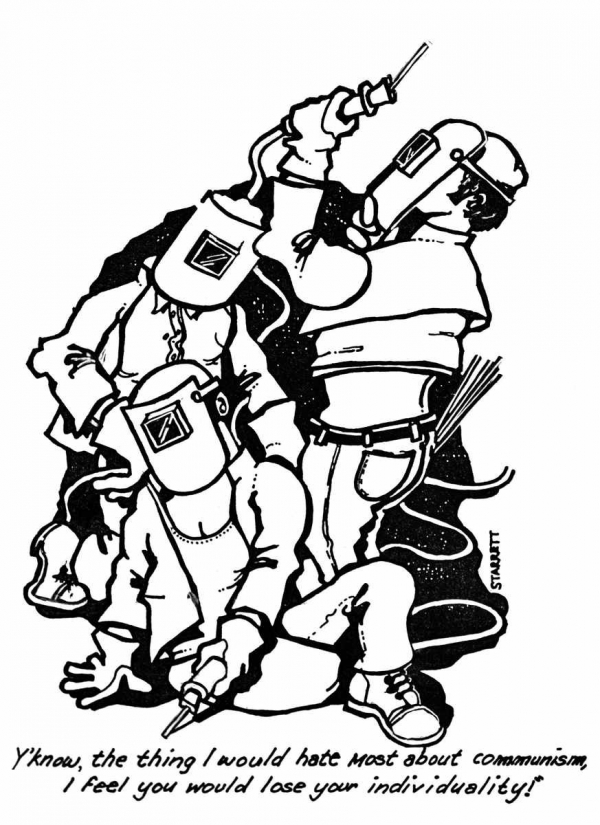A Comedy of Ideas: The Cartoons of Bob Starrett

David Betteridge introduces some of the cartoons of Bob Starrett, the official cartoonist of the Upper Clyde Shipbuilders Work-in of 1971-2.
When we look at Starrett’s cartoons, we may sometimes laugh Ha! ha! ha! in amusement at his portrayal of some silliness of human behaviour. We may sometimes laugh Ha! ha! in agreement with his satirical view of some political enemy. Most often, however, we laugh Ha! in delighted recognition of his skewering of some error, his highlighting of some truth, his scoring of some point. Such cartoons derive less from a comedy of manners, and rely less on caricature, than they express a comedy of ideas. To put it another way: in Starrett’s cartoons, we find less of the “good-tempered pencil” of a Fougasse, less of the personalised loathing of a Scarfe, and more of a focused analysis of the ways in which political wrongs operate. William Blake said that “a tear is an intellectual thing”. Starrett shows that a laugh can be an intellectual thing, too.

As well as attacking the functions and dysfunctions of Capital, Starrett also aims his fire at those aspects of everyday life that disfigure and divide the cause of Labour. Racism, sectarianism, and xenophobia are frequent targets of his. Like Brecht, Starrett “takes a bold sweep, never letting inessential detail or decoration distract from the statement, which is an artistic and intellectual one” (Brecht, Stage Design for the Epic Theatre, 1951); or, as Starrett himself once said, emphatically, in conversation, “No rococo.”
In the lines that Starrett draws, in the captions that he writes, and in the angles and points of view that he puts across, he is informed by a wide web of creative influences. Jimmy Airley, Jimmy Reid, Mick McGahey, Helen Crawfurd, Mary Barbour, Antonio Gramsci, Rosa Luxemburg, John Maclean, John Berger, Robert Burns, Dorothea Lange, Ben Shahn, Lindy Hemming, Mike Leigh, Ken Loach, Joan Littlewood, Bud Neill, Brendan Behan, Robert Noonan, Paul Robeson, Mahalia Jackson, and, most important of all, because they came first in Starrett’s education, Dunky Lamont and “all the guys in shipyards and on building sites who have given me ideas, themes and arguments” - they, and a long list of other thinkers, activists, artists, and writers stand behind him. Like them, and like the people for whom he draws his cartoons, Starrett looks with a sharp eye at the real world, engages with it, and shakes it until its contradictions rattle and its bubbles of absurdity go Pop!

Starrett learned the essentials of visualising and drawing by copying other people’s work, and by taking advice. He quickly progressed to producing work of his own, in a style of his own, readily identifiable as “Starrett”; but his individuality has always been a reflection of, and a reflection on, topics of popular and political concern, notably the class struggle of Labour against Capital. His cartoons have been gifts, freely given to that struggle, being grounded in it, usually drawn to order, under pressure of time. He was a founder member of the Glasgow Trade Union Centre Poster Group, a spin-off of the historic UCS Work-in of 1971-72.



Films - watching them, and working in them, initially with Bill Forsyth - are an important part of Starrett’s life. A favourite screen experience of his is re-visiting Charlie Chaplin’s great legacy, going back to the early days of cinema. (He has a boxed set of Chaplin’s films at home.) It is not surprising, then, that a recurring character in Starrett’s cartoons, The Worker, has certain similarities to Chaplin’s The Tramp. Both are resilient, resourceful, humane, strong, and clever. Both are constantly up against Wealth, Power, and Injustice, never weakening in their struggle to survive, and if possible prevail. There is, however, a significant difference: The Tramp is a marginalised individual, whereas The Worker is a member of that class in history that is not only the most exploited, but also the most creative. It is interesting to note that, according to the composer Hanns Eisler, Chaplin was a great teacher of Brecht’s. So Starrett and Brecht have that in common, as much else.
As well as being a cartoonist, Starrett is an author. A collection of his writings, The Way I See It, was published in 2013, by Fair Pley. These writings combine memoir, joke, description, and short story, sometimes with a dash of comment. Especially where his setting is the shipyards, Starrett employs (and quotes) a clear and flexible kind of language that Brecht would have called “gestic”: that is to say, a kind of language that embodies both thought and attitude in the very shape of a sentence: a kind of language in which gist and gesture work as one, with “no messing”. (This clarity and flexibility informed the great debates of the UCS Work-in that Starrett’s cartoons helped to commemorate, and fed into the epoch-making oratory of its leaders.) There is an affinity between the punchlines that come thick and fast in Starrett’s writings and the outlines of his cartoons.
More of Bob Starrett's cartoons are here.

David Betteridge
David Betteridge is the author of a collection of poems celebrating Glasgow and its radical traditions, 'Granny Albyn's Complaint', published by Smokestack Books in 2008. He is also the editor of a compilation of poems, songs, prose memoirs, photographs and cartoons celebrating the 1971-2 UCS work-in on Clydeside. This book, called 'A Rose Loupt Oot', was published by Smokestack Books in 2011.
